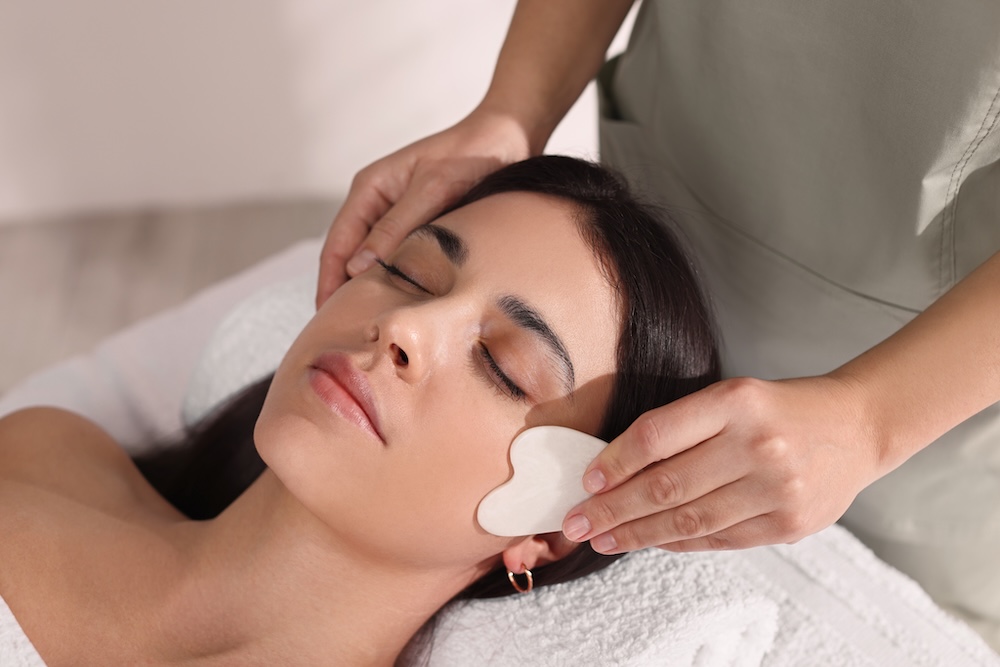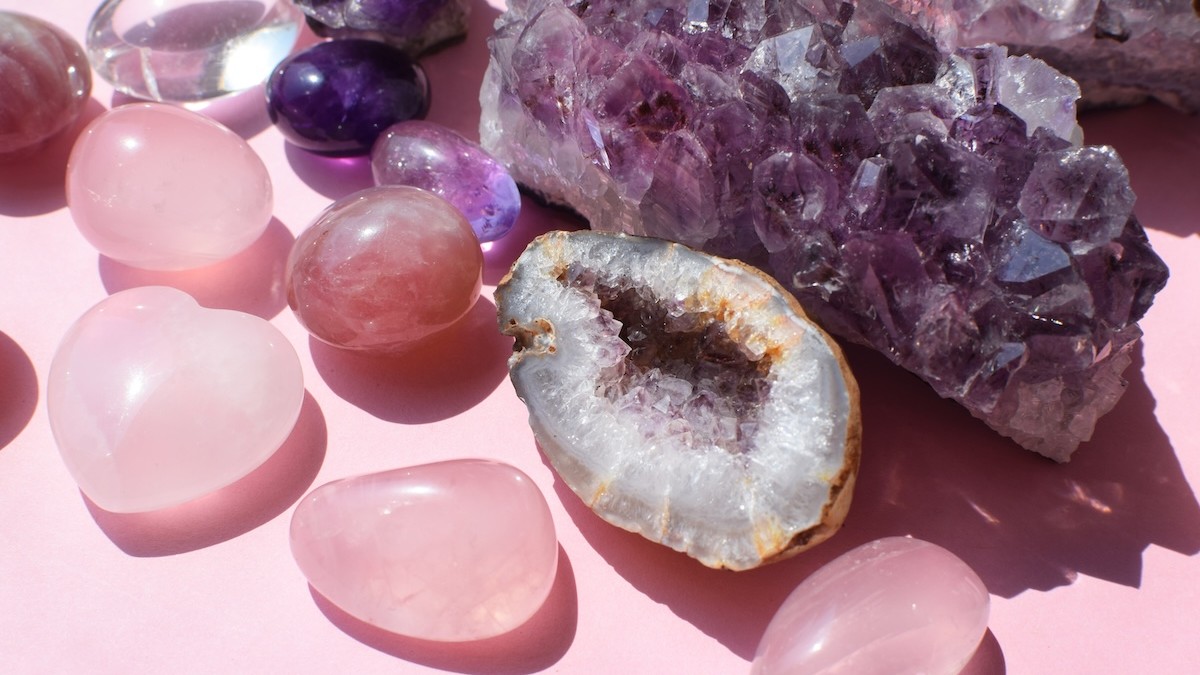Crystal healing is becoming increasingly popular in beauty and wellness, but how does it actually work in a professional treatment setting?
We speak to the experts to explore how beauty therapists can use crystals safely, ethically and effectively.
What is crystal healing in beauty treatments?
Crystal healing has become a familiar element in facials, massages and holistic spa rituals – but what does it actually involve?
According to Harmony Massage founders Wioleta Janik and Sohana Grace, “Crystal healing is a complementary wellness practice that uses stones and minerals (carved stones, palm stones, rollers, grids) as focal points for relaxation, intention-setting, and somatic touch.
“In beauty and spa settings, it’s usually applied as a tactile tool (for example, facial rollers, gua sha stones) and as a ritual: placing stones on or near the body, using them during massage, or encouraging clients to set an intention using a crystal.
“The effect for most people is calming, ritualistic and placebo-amplified, which can still be a legitimate part of a relaxing spa experience.”
This grounding, sensory-based approach is one reason crystal work continues to trend in wellness and self-care spaces.
A brief history: from ancient tools to modern spa rituals
Human use of gemstones in rituals, adornment and healing goes back thousands of years. As Janik explains, “Humans have used gemstones and polished stones for ritual and adornment for millennia, from ancient Egyptian amulets to Traditional Chinese Medicine tools.”
While crystals surged in popularity during the 20th-century New Age movement, their modern resurgence has come via beauty.
Grace says, “Crystals have moved from purely metaphysical shops into mainstream beauty: facial rollers, crystal gua sha tools, and crystal-infused product lines are now common in spas and online retail. Market demand and social media have greatly increased their visibility in aesthetics and self-care.”

How crystal healing differs from Reiki, aromatherapy and sound therapy
With the rise of holistic add-ons, clients often ask how crystal healing compares to other modalities.
Grace emphasises the difference in mechanism: “Aromatherapy and sound therapy have identifiable sensory inputs (smell and sound) with measurable physiological effects, while Reiki frames itself as hands-on energy work. Crystal healing primarily operates as tactile/ritual tools and symbolic anchors for intention and expectation.”
The visual and symbolic nature of crystals, alongside their popularity as physical tools, makes them unique in the treatment room.
The most popular crystals used in beauty treatments
Certain stones dominate professional beauty use because of their smoothness, weight and cooling properties. According to Janik, common choices include:
- Rose quartz – “used for ‘soothing’ and promoting a calming aesthetic; popular for facial rollers”.
- Jade – “traditional in East Asian beauty tools and marketed for cooling, lymphatic support, lift”.
- Clear quartz – “presented as a ‘versatile’ stone for clarity and amplification of intention”.
- Amethyst – “used in relaxation-focused rituals and associated with calm”.
- Obsidian/black tourmaline – “used in grounding rituals or as heavier gua sha stones for de-tensioning”.
She notes that “these stones are selected for weight, smoothness, temperature retention and symbolic association rather than proven biochemical action”.
Choosing the right crystal for each client
Client-led selection is a growing trend in modern spa experiences. Grace’s advice is to “ask the client what they’re drawn to, match tool to technique, consider contraindications and use intention.”
This client-centred approach enhances the therapeutic alliance and helps create a personalised ritual within a standard treatment.
How to incorporate crystals into facials, massage and nail treatments
Crystals can be added to almost any service, from luxury facials to express manicures. Janik and Grace outline several practical ideas:
- Facials: “use a cooled jade roller/ gua sha/crystal mushroom, place small polished stones or a crystal eye mask on the décolleté, temples or forehead during mask time, or use a crystal comb for a scalp massage”.
- Massage: “use larger, warmed or cooled stones as massage tools for extra glide or tension release”.
- Manicures/pedicures: “place small crystals in the soak bowl or use a crystal to perform a gentle hand massage”.
Crucially, they note, “Always frame crystals as a complementary, sensory-ritual element to the core technical service.”

Rituals and techniques: doing crystal treatments well
From sanitation to guided language, consistency matters. Grace and Janik's key recommendations include:
- For the sanitation ritual, cleansing the stone physically between clients; this reassures clients and keeps hygiene front and centre.
- Invite clients to set an intention, and use calm, scripted narration to guide the experience.
- Follow established facial anatomy and lymphatic directions and avoid pressure on sensitive areas.
Short, accredited training in gua sha is strongly recommended by both experts before offering crystal-based facial sculpting techniques.
How long crystal-enhanced treatments take
Crystal rituals can be added without significantly extending treatment time. According to Janik, “If crystals are added as an enhancement, expect 5-10 minutes extra. Most salons offer crystal add-ons as short upgrades rather than lengthening every treatment substantially.”
Combining crystals with aromatherapy, Reiki and sound therapy
Many spas blend modalities for a richer experience. Grace notes, “Combining modalities is common. Multisensory input (touch, scent, sound and ritual) can amplify the client experience.”
However, she emphasises the importance of transparency, consent and avoiding sensory overload.
How to explain crystal work to clients without overclaiming
When clients are sceptical, honesty is the best approach. Grace advises, “Explain what the practice does, and what it doesn’t have strong evidence for. Offer a short trial add-on and always avoid overclaiming medical benefits.”
This builds trust and aligns with industry regulations.
Contraindications, hygiene and safety considerations
Crystal healing may seem gentle, but there are important professional precautions. Janik and Grace highlight:
- Not using stones on broken, inflamed or infected skin.
- Steering clear of toxic or treated stones, as some minerals contain heavy metals or dyes.
- Sanitation: non-porous polished tools can be sanitised, whereas porous stones are less suitable for repeated skin contact
- Checking for allergies from coatings or fittings.
- Using gentler pressure in pregnancy or people with medical conditions.

Training and qualifications for crystal healing in beauty
For therapists wanting to upskill, their guidance is practical. “Look for short accredited CPD courses in gua sha and crystal facial techniques, infection-control training and reputable workshops on client-centred ritual and narrative,” says Janik.
Most professionals gain confidence within a few weeks of practice after completing a structured course.
How to market crystal healing treatments
Marketing crystal treatments requires a visual, sensory-led approach. Grace and Janik recommend:
- Show, don’t just tell: short videos of the tool in action perform well.
- Offer a trial add-on or first-time discount.
- Package crystal add-ons with popular services.
- Use sensory language and honest testimonials.
For pricing, Grace says, “Short add-ons (10-20 minutes) typically add £10-£30. Premium upgrades can include a crystal ritual, and series packages work well for repeat clients.”
Expert advice for therapists new to crystal healing
Janik and Grace’s top three tips are to “connect with your crystals, train first and be transparent with clients”.
And for creating a memorable experience, Janik says, “Make it multisensory and client-led; personalise the stone choice based on client preference.”
Common mistakes include poor sanitation, overpromising, improper technique and unsafe stones.
The takeaway: crystals as a ritual-enhancing tool, not a medical one
Crystal healing can be a powerful addition to spa and salon treatments when used safely, ethically and intentionally.
As Janik and Grace reinforce throughout, the true value lies in ritual, relaxation, skill, client connection and sensory experience – all elements therapists excel at delivering.
FAQs about crystal healing in beauty treatments
What is crystal healing in beauty treatments?
Crystal healing in beauty involves using specific stones, such as rose quartz, amethyst or jade, to support relaxation, energy balance and skin benefits during treatments like facials, massage and holistic therapies.
Which crystals are best for facials?
Rose quartz, amethyst and jade are the most commonly used crystals in facials. They are believed to support calming, soothing and depuffing effects, especially when used in tools like rollers, gua sha stones and crystal wands.
Do crystals really work in beauty treatments?
While scientific evidence is limited, many therapists and clients report enhanced relaxation, reduced tension and improved emotional wellbeing when crystals are used in treatments. The cooling touch of crystal tools can also support lymphatic drainage and skin soothing.
How are crystals used in a facial?
Therapists may place crystals on energy points, use crystal rollers or gua sha tools, perform gentle massage with crystal wands, or incorporate them into breathing and grounding rituals during the treatment.
Can any beauty therapist use crystals in treatments?
Yes, most beauty therapists can integrate crystals safely with basic training. However, many choose to take short courses in crystal healing or energy work to deepen their understanding and offer a more authentic, structured experience.
Do crystal healing treatments pair well with other holistic therapies?
Crystal healing combines well with aromatherapy, sound therapy, Reiki, breathwork and lymphatic drainage massage, enhancing the overall sense of calm and energetic balance.
How do I explain crystal healing to clients?
Keep the language simple and benefit-focused. Explain how crystals can support relaxation, grounding and skin-soothing effects, and reassure clients that the treatment is tailored to their comfort and preferences.
Are crystal healing treatments suitable for everyone?
Crystal-based techniques are generally gentle and suitable for most clients, though therapists should always carry out a consultation and avoid placing stones directly on areas of irritation, inflammation or open skin.
You might also like:



square.jpg)
